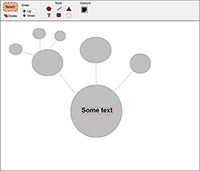8 Mapping your organisation

The following activity will help you chart the structure of the whole organisation (in terms of resource, activity and value).
Activity 4: Map your organisation and the way it speaks to itself
You are allowed to cheat: if you already have access to a pre-prepared diagram issued by your organisation, print that out or use it as a basis for this activity – but be prepared to change and amend it. Unlike many organisational charts, yours will present a richer ‘picture’ of the organisation, putting the case for each of its main sub-units and answering:
- why that unit matters in terms of its contribution to the mission of the organisation
- what work or action performed by that unit impacts (directly or indirectly) on your own role and work
- how you could enhance your knowledge of what goes on in that unit and what learning you could take from it.
Step 1: List the main functional units of your organisation. You might want to use an existing list or structural chart, but be sure to consider whether the list is accurate and useful. For example project teams may not be listed on the chart but if they are a meaningful entity to you, list them; some departments may be large, and in terms of your interaction with department members it may be useful to split the department into sub-units for the purposes of the activity.
To complete the next part of this activity you are invited to use an interactive whiteboard tool again, see Figure 8 . The tool will save whatever you draw here on this site so you can return to it during your study. If you would rather perform this activity on a large piece of paper please do so, but keep it safe to refer to in future activities.
Click ‘View’ to access the interactive whiteboard tool. There are a number of shape tools available to choose from, as well as the ability to enter text. Once you have created an element of the map you can use the ‘Select’ option to drag and drop it, the Order ‘Up’ and ‘Down’ buttons to move it to the foreground or background, or the ‘Delete’ option to get rid of it entirely. After you have mapped the stakeholders you can save your final map here and also export a copy to print off.
Step 2: Once you’re happy with your list, arrange the units in labelled blocks to form an organisational landscape. Traditionally the arrangements of organisational charts are made on the basis of management levels: who is in charge of what and who reports to whom. That arrangement could be highly useful (particularly if you’re a director or senior manager!) but here you are urged to take a more innovative approach. Here are some ideas:
- Place your own unit in the centre, those with which you deal surrounding your own, and beyond them, further units – a similar arrangement to what you were asked to produce in Activity 2, but this time ensuring all units are represented, even if you don’t tend to interact with them. You want to capture a broad picture of your company.
- Place customers or end users of a service at one end of the paper, and have other units back up to them according to their proximity to the customer interface.
- Pick the unit you are least familiar with, and arrange unit blocks around it, to include (eventually) the functional area in which you work. The idea here is to give you a radically different perspective. It’s perhaps the most difficult way to do the exercise – but it may be one of the most informative.
Step 3: Once you have a chart, answer the following three questions for each unit block. You may like to use different coloured text or different style text boxes so you can link your three responses to the relevant place on your organisational map.
- a.Why does this unit matters in terms of its contribution to the mission of the organisation?
- b.What work or action performed by this unit impacts (directly or indirectly) on your own role and work?
- c.How could I enhance my knowledge of what goes on in that unit and what useful learning could I take from it?
Feedback
- a.Understanding shared goals and differences in role allows you to delineate spheres of responsibility (to have greater clarity over who does what and why) yet at the same time to do things that appear to defy delineation: to open up windows of opportunity in terms of collaboration, and to develop business solutions which acknowledge and respond to the needs and purposes of other teams.
- b.There will be obvious impacts (failure to supply X will stop us doing Y) but also more subtle impacts – if they give us less of X we could have more time to do Y. This question explores connectedness, and suggests there is use in you knowing how the actions of others have an effect on you – so you can prepare for and pre-empt those actions.
- c.The term ‘useful learning’ should be explored here. There may be things you can take from the other units now which can directly assist your current work. But be aware that this is a reductionist response to what is and isn’t useful. Learning what are the current issues and challenges within another unit is not only useful in itself (to make you a stronger organisational player and contributor) but it primes you for more agile and creative responses to challenges that you and your team may face in the future – a future that certainly holds unknowns.

